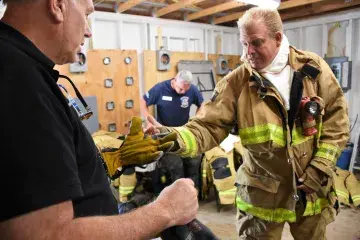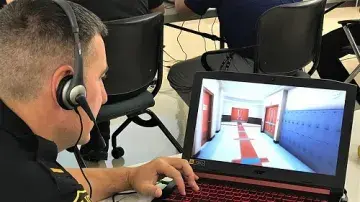In recent years, our nation has witnessed several of the worst wildfire seasons in history, public health crises like the COVID-19 pandemic, mass casualty events, and more. First responders are on the front lines leading the battle against each of these challenges—and this is in addition to all the other ‘everyday’ community emergencies. It is an awesome responsibility, to be sure, and it takes a toll. That’s why the Science and Technology Directorate (S&T) continues to fulfill its mission to arm responders with cutting-edge technologies, tools, and information to allow them do their jobs safely and effectively.

S&T doesn’t do this in a vacuum; rather, we bring together first responders from across disciplines and across the nation to find out what they need and why, then we focus the R&D community on affordable solutions and leverage responder feedback to develop and commercialize them.
S&T’s First Responder Resource Group (FRRG), representing a diversity of responder disciplines, roles, locations, and agency size, is particularly essential – coming together to share knowledge and experience to highlight shared capability needs and the development of solutions. The recently-released Project Responder 6 (PR6) is the latest iteration of this effort: a comprehensive study of emergency response capability needs across changes in the operational environment. The outcomes of this report will guide S&T R&D and acquisition decisions for the responder community for years to come.
“The FRRG is unique in that we ask first responders to share their individual experiences, challenges, and knowledge with us, so we at S&T can determine how to provide a solution,” said Paul McDonagh, who leads the FRRG and S&T’s First Responder Disaster Resilience portfolio. “We are working to make the responders better connected, protected, and fully aware, and that is making our communities safer and more resilient.”
What S&T learned from FRRG members in gathering feedback for PR6 is that the lines between responder disciplines are blurring, and the final report reflects this reality. “The traditional model of fire engine and squad car to the front yard, ambulance to the ER, is less and less applicable, more and more of the time, as we encounter mental illness, homelessness, and other social problems,” said Jay Hagen, chief of the Bellevue (Washington) Fire Department. “We need to morph our capabilities to address these issues. Our communities are going to demand we adapt, and to stay flexible, we will need technologies, tools, and guidance that will help us on the greatest number of missions possible. S&T’s FRRG has brought us into the discussion of what’s possible.”
Dr. Carol Cunningham, State Medical Director, Ohio Department of Public Safety, Division of EMS, agreed: “What is unique about the Project Responder effort is information sharing across disciplines, nationwide. Some technologies and tools associated with firefighting, such as gloves and other PPE, are also applicable to the EMS operational environment.”
And while it is critical for S&T to hear directly from these responders, forums like these are also important to the responders themselves, who get to hear from their peers about successes and challenges in states and communities across the U.S.
“The networking we get from being connected within FRRG gives me a broader group of colleagues to reach out to whenever I’m researching different technologies or have questions about their experiences,” said Red Grasso, Director or the First Responder Emerging Technologies Program, North Carolina Department of Information Technology. “PR6 has helped us find out the needs of responders without having to duplicate at the state level what’s being done at the national level.”
Direct engagement with S&T’s FRRG benefits state and local agencies to a degree that is difficult to achieve by any responder agency acting on its own. S&T has long been committed to providing this support—the overall Project Responder effort has surveyed responder technology needs for nearly two decades so far and produced six reports.
“PR6 is really an impressive collaboration between members of the first responder community. For over two decades, the Project Responder effort has been the foundation for guiding homeland security research to support the public safety community. Without the support of the first responder community, Project Responder would not be possible,” said Dan Cotter, Executive Director of S&T’s Office of Science and Engineering.
The feedback gathered from responders over the years has resulted in more than just reports. For instance, thanks to S&T’s efforts, a key technology first envisioned in Project Responder 3 (PR3, 2014) has spurred industrywide innovation since.

“Nothing illustrates better what S&T’s FRRG does in the Project Responder effort than the structure firefighting glove,” said Steve Vandewalle, helicopter rescue medic with San Diego Fire Department. “What I needed was a glove with thermal protection that was easily donned and doffed and that allowed me to use a touch screen. With industry partners, the Illinois Fire Academy, the National Institute for Occupational Safety and Health and the National Fire Protection Association, we went through six iterations of the glove. After we produced our glove, other glove manufacturers made improvements to stay competitive. The glove I have now is better, thanks to the collaboration S&T brought about.”
Another set of innovations that resulted from Project Responder series includes S&T’s 3D tracking technology POINTER, which addresses the need to locate responders inside a structure—a need that has been a high priority across all six iterations of Project Responder. Vandewalle calls POINTER “the greatest success of the FRRG…a game changer not only in the firefighting environment, but also for law enforcement, the tactical environment for high-risk warrants, mining collapses, and urban search and rescue.” Phase II of POINTER, locating responders in outdoor and crowded environments, kicked off in July 2022. In conjunction with POINTER, S&T is now developing the Data Upload Mechanism for First Responders, which displays floor plans and other critical data for buildings, further enhancing responder safety.
Looking to the future, FRRG members discussed with us current R&D efforts they see as promising for their operations. “The wearable chemical sensor, which warns responders of exposure to hazardous substances so that they can don the appropriate PPE, could eventually give way to a wearable device that detects a contagious pathogen and helps with disease tracing,” offered Cunningham.
Two responders offered that emerging virtual tools are essential. “Since fire prevention has improved so much, we now rely less on direct experience and more on simulations, lessons learned, shared platforms, video training tools, and the science of decision-making,” said Hagen.
And for Rodney Reed, Assistant Chief, Operational Support for the Harris County (Texas) Fire Marshal's Office, “Virtual reality and augmented reality are valuable as training tools because they offer enhanced capabilities to responders in rural America who face the same threats as responders in metropolitan areas but have resource constraints.”

One example of an existing S&T technology in this space that came out of a previous Project Responder report is the Enhanced Dynamic Geo-Social Environment (EDGE). Already commercialized, this free virtual training platform for coordinating the response to active shooter incidents, was the highest-priority capability need identified in PR3. More recently, EDGE has emerged as a tool to enhance school safety and can be used to prepare for a wide number of critical incidents as well. While EDGE continues to be a force multiplier in the virtual training environment, S&T also is continuing to explore technologies to expand and customize training offerings for complex incident command and management.
Beyond Project Responder, connecting the R&D community with first responders is a vital mission for S&T. They not only help S&T to chart a technology roadmap based on their current and future needs, but they also inform every step of the process—from initial design to operationally field-testing prototypes to preparing to transition technologies to the commercial marketplace. And this is not a responsibility that the FRRG members take lightly. As Vandewalle sums it up, “I believe it is our job as the FRRG to improve the state of the technology to benefit first responders. You can’t find this kind of collaboration anywhere else.”
For more information about S&T’s first responder mission, please visit our First Responder Capability page and listen to our ‘The First Responder Group Doesn't Just Do Widgets’ podcast episode. For related media inquiries, contact STMedia@hq.dhs.gov.
